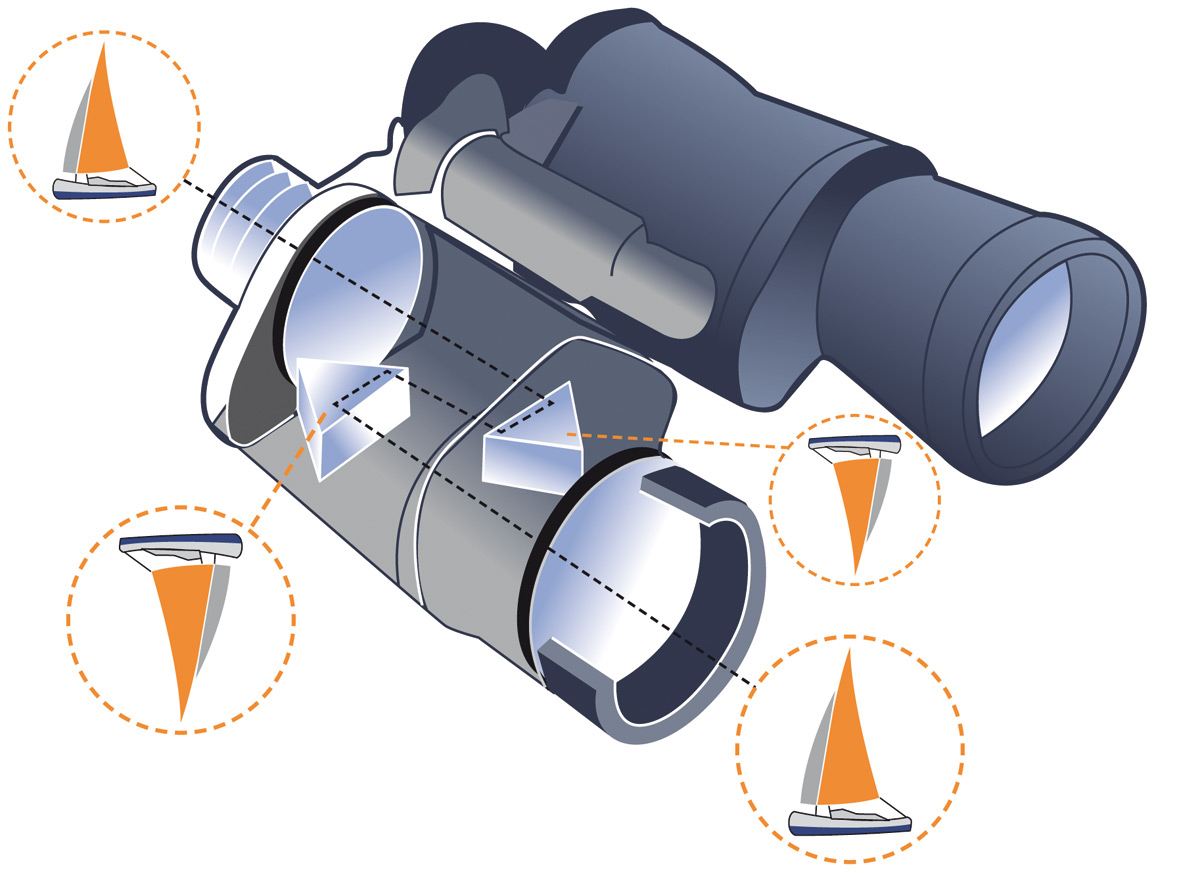Almost indispensable
Waterproofing
The first criterion to consider in selecting binoculars is the waterproofing. On an open shell boat, a pneumatic or simply for use in all weathers, without hesitation one must take an immersion proof model (at least 2m.) Caution; waterproofing is not simply for moored boats. A pair of waterproof binoculars will hold up better over time. It is not uncommon for prisms to be affected over winter, simply by being left on boats.
Magnification
The second point is the magnification. On a moving vessel, if the magnification is too high, the image will not be stable and framing an object almost impossible. The practical choice is a magnification of around x7. On a stable boat this may be increased to x10.
Brightness
The third criterion is the diameter of the objectives which determines brightness. It must be between 30 and 50. With these numbers we arrive at the models, 7x30 or 7x50. The larger the diameter of the lens, the more light it collects and the better the vision in poor conditions, or at night. Note that the best manufacturers of binoculars ensure that the lenses which constitute the objective so that they are crossed by the maximum of light. A low end range lens retains a great deal of light.
The field
This value, indicated in metres, corresponds to the width seen through the binoculars at 1000m; the wider the field, the greater the width seen by the binoculars. For 7x50, it is low, around 110m and very good at 130m.
Professional advice
“Before completing any purchase, hold the binoculars upside down and look through the lens, you should see the ring which gives the ocular diameter. If it is distorted, it is not a quality optic.”
“Before completing any purchase, hold the binoculars upside down and look through the lens, you should see the ring which gives the ocular diameter. If it is distorted, it is not a quality optic.”
Night vision
The monocular light intensifier (night vision,) can not be considered for the binoculars. If it amplifies the light at night, they have a maximum magnification of just x2 or x3. They may be used once one arrives at an anchorage to seek a better position among the other boats, not to see far.
How do they work?
Binoculars consist of three essential items:
-a prism responsible for correcting the image
-an ocular mechanism turned toward the eye
-An objective.
The prisms
Without them the image would be upside down as in an astronomical telescope. Two solutions have been selected to rectify this, the Porro prism system or roof prism system.
The Porro is most commonly used. The realization is relatively simple for the user, the setting is practical, their only flaws that they are relatively bulky and heavy. Roof prism models, also called, “type H,” are compact and lightweight. In contrast the manufacturing and alignment of prisms when mounting is delicate.
The eyepiece
The eyepiece contains a lens that permits the watching of a subject at a short distance. As this object may not remain at the same distance, to keep this sharpness the distance objective is adjustable. This adjustment is made by rotating a ring simultaneously or independently in both eyes (roof prism.) Note that there are models which do not require adjustment; they remain to within a few metres to infinity.
The objective
Binoculars are always defined by two numbers, for example 7x50. These values correspond to the magnification and the diameter of the objective. In the example 7x50, they have a magnification of 7 and a lens diameter of 50mm. In practice, an object placed at 1000 metres, with a magnification of 7, appears to the eye as if at
143metres (1000/7.) The diameter of the objective determines the amount of light captured. The pupil of the eye has a diameter of about 7mm when completely dilated. For the eye to capture maximum light, it is necessary that the ratio of objective diameter and magnification are of the same order, in this case, 7x50 it is 50/7=7.
-a prism responsible for correcting the image
-an ocular mechanism turned toward the eye
-An objective.
The prisms
Without them the image would be upside down as in an astronomical telescope. Two solutions have been selected to rectify this, the Porro prism system or roof prism system.
The Porro is most commonly used. The realization is relatively simple for the user, the setting is practical, their only flaws that they are relatively bulky and heavy. Roof prism models, also called, “type H,” are compact and lightweight. In contrast the manufacturing and alignment of prisms when mounting is delicate.
The eyepiece
The eyepiece contains a lens that permits the watching of a subject at a short distance. As this object may not remain at the same distance, to keep this sharpness the distance objective is adjustable. This adjustment is made by rotating a ring simultaneously or independently in both eyes (roof prism.) Note that there are models which do not require adjustment; they remain to within a few metres to infinity.
The objective
Binoculars are always defined by two numbers, for example 7x50. These values correspond to the magnification and the diameter of the objective. In the example 7x50, they have a magnification of 7 and a lens diameter of 50mm. In practice, an object placed at 1000 metres, with a magnification of 7, appears to the eye as if at
143metres (1000/7.) The diameter of the objective determines the amount of light captured. The pupil of the eye has a diameter of about 7mm when completely dilated. For the eye to capture maximum light, it is necessary that the ratio of objective diameter and magnification are of the same order, in this case, 7x50 it is 50/7=7.

